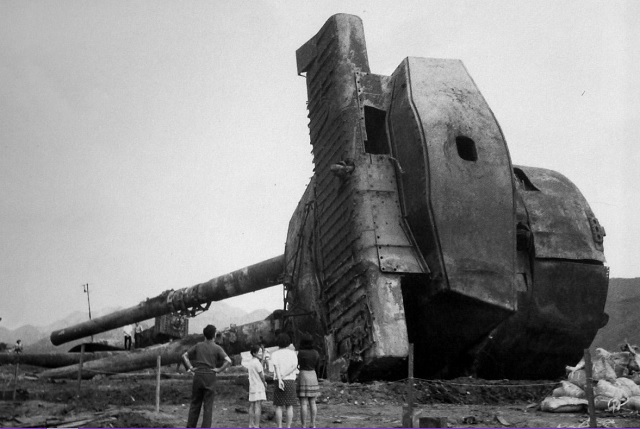July 03, 2014

That is one of the Mutsu's main turrets after salvaging post-war. The ship was in harbor in 1943 when it apparently killed itself, suffering a massive internal explosion that cut it in half. Only some 350 men out of a complement of nearly 1500 survived. The two aft turrets were salvaged in 1970-71.
What an amazing picture.
Posted by: Wonderduck at
09:03 PM
| Comments (9)
| Add Comment
Post contains 63 words, total size 1 kb.
I hadn't properly appreciated just how much armor was on a battleship turret until I saw the Mo. You just... I mean, you don't encounter that kind of thickness of steel in civilian applications. Even really large girders aren't that much solid steel, usually. (And there were a couple of other positions which had almost as much armor, notably the helm...)
Posted by: Avatar at July 04, 2014 04:54 AM (ZeBdf)
Posted by: Siergen at July 04, 2014 02:55 PM (8/vFI)
Posted by: Mauser at July 04, 2014 02:55 PM (TJ7ih)
Having said that, it's a 55000ton battleship... its very size is probably the best armor against a weapon with a 360lb warhead.
Posted by: Wonderduck at July 04, 2014 03:10 PM (mOdOJ)
It all depends on where it hits, and what kinds of damage it causes. One of the earliest attacks on Yamato was by dive bombers, and one theory is that one of those bombs (500 lb.) started fires which eventually reached one of the magazines and set off an explosion which blew the ship in half.
That said, I don't think the Exocet is a pop-up-dive-down missile. I think it just sails in horizontally and strikes the target.
Another example: I assume you've all seen the gun camera footage from when a couple of P-47's belonging to the Tuskegee Airmen strafed a German (reflagged from Italian) destroyer in the northern Adriatic and eventually blew it up? I am pretty sure what happened is that one of the .50 rounds hit the warhead on a torpedo and set it off, and then all the other torpedoes on the rack. The resulting explosion was easily enough to blow the ship apart.
I don't think Missouri carried anything like that on its deck, and of course it was a lot bigger than that destroyer, but there was a lot of ordnance on that ship, and leveraging that kind of thing has a long and glorious history. (See e.g. HMS Hood.)
Posted by: Steven Den Beste at July 04, 2014 04:32 PM (+rSRq)
The late David Brown noted that a kamikaze strike was a useful indicator of the effect of modern ASMs. Any place protected by the armor belt will generally be fine. Any place that is not protected by the armor belt will be in trouble. Since modern ASMs are not specifically designed to attack heavily armored targets, the comparison seems apt.
If a guided missile was designed specifically to attack heavily armored targets, like the Fritz X, then bad times would await the target, regardless of how heavily armored she was (Re: Warspite, Roma, et al.)
(And there were a couple of other positions which had almost as much armor, notably the helm...)
Unless you were on a new or rebuilt British battleship.
Posted by: cxt217 at July 04, 2014 06:19 PM (PE4d7)
Of course they might do it different in Japan.
Posted by: The Brickmuppet at July 04, 2014 07:24 PM (DnAJl)
Posted by: David at July 04, 2014 09:18 PM (da+4f)
Posted by: Wonderduck at July 04, 2014 09:26 PM (mOdOJ)
47 queries taking 0.7352 seconds, 285 records returned.
Powered by Minx 1.1.6c-pink.









